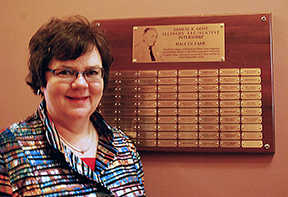Executive Director’s Message: Funding, Teacher Shortages & Tier 3 Planning
If you can count on anything during the annual spring session of the General Assembly, you can be sure there will be intense discussion over Illinois’ public pension systems, including TRS.
Because 2018 is an election year, the debate over what your retirement plan will look like in the future has ramped up exponentially.
As the legislative session and the campaign season progress, I’d like to take an opportunity to remind you of the limited role that TRS plays in the formation of new laws, the state budget and other government policies.
Due to our fiduciary duty to you, TRS cannot – and does not – lobby or take a stand on any legislative proposal that in any way affects member benefits. TRS will provide analysis and information on a nonpartisan basis to state officials upon request to help inform their policy choices. But TRS does not create or suggest changes in the pension code that affect benefits.
With that said, TRS does engage legislators and other state officials for two important reasons. The first involves any needed technical changes to new or existing state laws.
The other reason we lobby government officials involves state funding for TRS. Our fiduciary duty to you requires us to advocate for stable and adequate funding. And we do… continuously.
Now that we’ve discussed the limits of what we can and cannot do, here are some facts and statistics that underlie the current pension debates in Springfield.
State Funding for TRS
State officials should fund TRS at levels that not only pay the current cost of pensions being earned by active teachers, but also enough money to chip away at the unfunded liability.
TRS remains underfunded and carries one of the poorest funded ratios, 40.2 percent, of any public pension plan in the country. The current long-term unfunded liability is $73.4 billion and was largely caused by decades of state payments to the System that failed to meet the actuarial minimum for “full funding.”
For example, between 1984 and 2017, state government shorted TRS by a total of $32.7 billion. Even so, current law only requires the State of Illinois to fund TRS over the next 28 years at levels designed to bring our funded ratio up from 40 percent to 90 percent – not the full funding that should be the goal.
With all the other financial problems currently plaguing state government, appropriating “full funding” amounts for TRS and the other state systems is a difficult vote. We are not alone in requesting a budget priority. The plain fact is, state spending on TRS and the other state pension systems already is one of the largest parts of the state budget. Next year the cost of pensions is expected to account for 22.5 percent of the budget.
TRS will continue to do all it can in 2018 to make sure state funding for TRS and the other pension systems remains a priority for state officials and at least follows the current funding plan. Teacher pensions have been promised by state government for more than 100 years and those promises must be kept for the present and future generations of TRS members.
Pension Cost Shift
Shifting the responsibility for the cost of pension benefits earned each year by TRS members from the state to local school districts is an idea that has been floated in the Illinois Capitol for several years.
TRS will not take a position on this concept because our fiduciary duty to our members leads us to accept funding from whatever source the legislature determines is prudent.
The current cost shift proposal would phase in a transfer, over four years, of each school district’s pension “normal cost” from the state budget to each district’s budget. We can only estimate what the impact would be on local budgets but it would be higher than what is required currently.
Teacher Shortage in Illinois
The General Assembly and the Illinois State Board of Education are examining various ways to combat a shortage of classroom teachers in Illinois schools. This is another issue where TRS will not endorse or oppose any specific solution. Some proposals already under discussion have centered on expediting the licensure of college students to allow them to teach before receiving their degrees or increasing the number of days that retired TRS members may return to the classroom.
As the discussion continues, we will work with all parties involved to make sure that any changes to state law will fit within the legal parameters of the pension code.
Tier 3 Planning
Under the state law enacted last summer, TRS must implement the new Tier 3 benefit structure “as soon as possible.” Tier 3 will be an optional plan open to all Tier 2 members and new educators hired after it becomes effective. The new plan is comprised of a defined benefit pension and a defined contribution savings plan much like a 403(b).
However, a close review of the law has revealed a number of contradictions between existing statutes that govern Tier 1 and Tier 2 and the new language for Tier 3. Technical language to fix these issues, and others, has been submitted in a “trailer bill” that is pending before the legislature. But until these issues are resolved, TRS cannot proceed further. TRS will not guess what the intent of lawmakers might be on specific questions.
As we wait for legislative action, TRS is proceeding with a major change in the way member information is reported by school districts to the System. Right now, service and salary information is submitted annually. The new system will require monthly reporting by school districts. This will enhance our on-going administration of benefits and will be required by any future Tier 3. More to come on this project in future issues of Topics & Report.
Sincerely,
Dick Ingram
TRS Executive Director
TRS Investments End Calendar Year 2017 With Historical High of $51.3 Billion
TRS investments ended calendar year 2017 on a high note. The portfolio recorded a positive rate of return of 14.49 percent, net of fees, for the 12-month period.
Total assets under management by the System grew by 11.4 percent during 2017 to $51.3 billion, the largest total in the history of TRS.
Moreover, the important 30-year investment return was a positive 8.57 percent, a rate that continues to exceed the System’s long-term assumed investment return rate of 7 percent. The 30-year result is an important benchmark because TRS enjoys a relationship with many members that spans several decades.
However, growth in the investment portfolio will never generate enough money to close TRS’s $73.4 billion long-term unfunded liability. That deficit was caused by decades of inadequate contributions by state government. Between 1984 and 2017, the state underfunded TRS by $32.7 billion.
The key to eliminating the System’s unfunded liability is adequate and consistent funding from state government that contributes to the cost of benefits and chips away at the unfunded liability. Current state law mandates a government payment schedule designed to increase the TRS funded status from the current 40 percent to 90 percent by 2045.
TRS has been “treading water” financially for decades and has never failed to pay benefits to all eligible members. We will monitor our funded status carefully because our margin of safety is small. Total benefits paid out totaled $6.1 billion in fiscal year 2017. Total System revenue during the same period was $10.6 billion.
Splitstone and Kearney Appointed to TRS Board


In December 2017, Gov. Bruce Rauner appointed Mark Splitstone and Tracy Kearney to the TRS Board of Trustees. As of this publication, 12 of the 13 total TRS trustee seats are filled – four elected by active members, two elected by annuitants, five appointed by the governor and the state superintendent of education, who by law serves as the president of the Board. The open seat is a gubernatorial appointment.
The son of a college professor, Mark Splitstone grew up in Belleville and graduated from Belleville East High School. He graduated with high honors and a bachelor’s degree in finance from the University of Illinois at Urbana-Champaign and earned a master’s degree in business administration from the Kellogg Graduate School of Management at Northwestern University in Evanston. He has held senior level finance roles at a number of large
corporations, including Emerson Electric and RR Donnelley. Trustee Splitstone lives in Elmhurst with his wife, Anne Marie, and their children, Matthew and Allison, who are both sophomores at York High School.

A graduate of the University of Colorado at Boulder with a degree in political science, Tracy Kearney currently is vice president of mortgage lending at Guaranteed Rate, Inc. a residential mortgage company headquartered in Chicago. Previously, Trustee Kearney was a portfolio manager and proprietary trader at the Chicago Board of Trade, a development consultant for non-profit organizations and a legislative aide based in Washington, D.C. for former U.S. Rep. Scott McInnes of Colorado. She was elected to the Wilmette Public Schools District 39 Board of Education in 2015. Trustee Kearney previously served District 39 students and staff in various capacities with the District 39 Educational Foundation, including a term as the foundation’s chair. She lives in Glenview with her husband Joe and their three boys, Charlie, Will and Joey.
Upcoming Board Meetings
April 26-27, 2018 - Spfld. Retreat
May 24-25, 2018 - Rosemont
June 21-22, 2018 - Spfld. (tentative)
Video Highlights Your Retirement Planning
It’s never too early to start thinking about your future.
A new TRS video outlines the role TRS plays in your life and what you can do to enhance your retirement planning throughout your career in education. TRS is with you every step of the way.
Watch the short video on YouTube: https://youtu.be/tYkhCWwdhdc
Marcilene Dutton Named to the Illinois Legislative Internship Hall of Fame
TRS Chief Legal Counsel Marcilene Dutton recently became one of the newest members of the Samuel K. Gove Illinois Legislative Internship Hall of Fame, which honors former students at the University of Illinois – Springfield who have distinguished themselves during their subsequent careers in Illinois state government.
Marcy followed her 1985-86 legislative internship by graduating from law school at Louisiana State University. A former member of the Illinois Senate Republican Staff, Marcy has spent the majority of her professional career focusing on public service and education. Prior to joining TRS in 2016, Marcy served eight years as assistant general counsel at the Illinois State Board of Education.
Established in 1990, the Hall of Fame now includes several current and former members of Congress, state legislators, state agency directors, a former U.S. Attorney and former Gov. Jim Edgar.
Keep Us Informed of Your Life Events: Complete Forms and File Proof of Birth
Review Member Information and Beneficiary Designation
If you have recently become a parent, or have been married or divorced, you will want to review your Member Information and Beneficiary Designation online in the secure member area, https://member.trsil.org/subsections/secureaccountaccess/security/signin.aspx. This important form designates who will receive your death benefits from TRS. Update your Member Information and Beneficiary Designation (MIBD) form (https://www.trsil.org/MIBD_form) to ensure that survivor benefits will be paid according to your wishes.
File Proof of Birth with TRS
When changing an MIBD form, all active and inactive members (not retired) must indicate on the MIBD whether they are including a proof of birth or have previously filed it with TRS. Proof of your birth date must be on file with us before a benefit can be paid. Acceptable proof includes a copy of either a birth certificate, a valid driver’s license, valid passport or valid state-issued identification card. For instructions on how to send TRS your proof of birth, visit the online member area. When active or inactive members log on to the secure Member Account Access area, the site denotes whether a member has proof of birth on file with the word “validated.”
Retired members do not have to file proof of birth because they are already receiving benefits.
Complete Name Change Form
If you have recently married or divorced and need to change your name, fill out the Notice of Name Change form (https://www.trsil.org/forms/name-change). A photocopy of your marriage certificate, valid driver’s license, certified court order, valid U.S. passport or valid state ID must be submitted with the form when you provide it to TRS.
Notify TRS When Your Address Changes
To ensure that all information about your benefits reaches you, please call or email us when your mailing address changes. Provide:
- your full name and the last four digits of your Social Security number;
- former street address, city, state, and ZIP;
- new street address, city, state, and ZIP; and your
- daytime telephone number.
TRS’s Commitment to Hiring Women and Minority-owned Investment Firms

A key component of the TRS investment program is the System’s dedication to diversity in hiring qualified money managers and brokers to manage member assets. TRS maintains a robust program to identify women and minority-owned business entities, or WMBE firms, to oversee portions of the System’s portfolio.
Over the last 18 months, TRS efforts to attract and use “WMBE” firms have consistently exceeded TRS’s goals.
At the end of fiscal year 2017 in June, TRS exceeded its benchmark in the total amount of the System’s portfolio managed by WMBE companies.
In all, 33 WMBE firms administered $8.9 billion, or 18.23 percent of the total TRS portfolio, exceeding the year’s goal of 17 percent. By December 31, 2017, total WMBE assets had grown to $9.6 billion, or 18.74 percent. As a result, the TRS goal was raised to 18 percent.
Since 2007, the TRS Emerging Managers Program (EMP) a key means of identifying smaller and emerging investment managers. The EMP is open to all small firms trying to gain a foothold in the competitive investment marketplace, although 43 of the program’s 47 participants over time are or were WMBE firms.
Currently 19 companies are in the program administering $545 million in assets. Fifteen of the EMP participants have “graduated” from the program and now administer $2.8 billion of total TRS WMBE assets.
For the last 14 years, TRS has hosted an annual “Opportunity Forum,” which brings WMBE companies (many not working currently with TRS) together with representatives from the System’s current roster of investment managers.
This year, 106 companies gathered with TRS trustees and staff in Springfield to build new relationships.
TRS continues to be recognized as a national leader in these efforts and will often have peer systems look to TRS for guidance.
Benefit Choice Period for Health Insurance Coverage Planned in May
The annual Benefit Choice Period for Teachers’ Retirement Insurance Program (TRIP) participants is planned for May 1 through May 31, 2018. TRS will post any updates about the Benefit Choice Period on our website.
This Benefit Choice Period is not for members currently enrolled in the State of Illinois Medicare Advantage Plan - Total Retiree Advantage Illinois (TRAIL). The Benefits Choice Period for TRAIL participants will be held in the fall.
Benefit Choice is the time to make changes in TRIP coverage and to enroll yourself and eligible dependents if you have never previously been enrolled. The information about the Benefit Choice Period will be mailed to retirees currently enrolled in TRIP at the end of April. The mailing will include an explanation of health insurance options for the coming year and changes in coverage benefits. The full Benefit Choice booklet will be available at http://www.benefitschoice.il.gov, the Illinois Department of Central Management Services (CMS) website and also on MyBenefits.illinois.gov.
If you already are enrolled in TRIP and wish to make a change in coverage, call My Benefits Service CenterMBSC) at (844) 251-1777 or log in at MyBenefits.illinois.gov. If you are enrolling yourself or an eligible dependent for the first time during the Benefit Choice Period, please contact TRS for a TRIP Participation Election form.
If you do not want to change your coverage, you do not have to do anything. Your current coverage will continue.
TRS does not administer TRIP. As a reminder, TRS determines eligibility, assists with enrolling members in the program and collects appropriate premiums. By law, CMS is the administrator that determines coverage benefits, establishes premiums, negotiates contracts with the insurance carriers, and resolves coverage and claim issues.
MBSC is the custom benefits solution service provider for CMS and can answer questions about changing coverage or electing benefits.
Prepare for Retirement by Using This Retirement Time Line Checklist
As Soon as Possible
- If you have not already submitted a “proof of birth” online in the Member Account Access area, it must be provided to TRS in order to process your retirement benefit.
- Update your years of service. Obtain the cost of reinstating a TRS refund, record sick leave from former employers and report optional service. Types of optional service include:
- substitute teaching,
- homebound or part-time service before July 1, 1990,
- out-of-system service,
- military service,
- board-approved leaves of absence,
- leaves of absence due to pregnancy or adoption prior to July 1983, and
- involuntary layoffs.
- Update your Member Information and Beneficiary Designation (MIBD) form to ensure that survivor benefits will be paid according to your wishes.
- Provide us with your home email address in the secure Member Account Access area. Emails about legislation and other important events will also be sent as needed.
- Review the TRS Member Guide.
- Inquire about upgrading your pre-July 1998 service to the 2.2 formula. Call us for the cost to upgrade.
- Consider consulting with a financial planner. TRS does not provide financial advice.
- Determine if any reciprocal service you have accrued will be beneficial to use in retirement. Each retirement system has specific rules about reinstating refunded service.
4 to 5 Years Before Retirement
- Attend a pre-retirement meeting. A schedule is available on the TRS website during the fall.
- Request a benefit estimate online in the secure Member Account Access area or by calling us. We will need to know your estimated retirement date; the number of unused, uncompensated sick leave days at retirement; and current and estimated future salary rates, including TRS contributions. Also include any bonuses and extra-duty pay.
2 Years Before Retirement
- Request an updated benefit estimate (online or by phone).
- Attend a pre-retirement meeting.
- Finish reporting all optional service; this task may take time and research.
- Complete payment to reciprocal system for refunded service, if applicable.
6 - 12 Weeks Before Retirement
- Complete the Personalized Retirement Interview by calling us or logging on to the Member Account Access area of our website. You’ll be asked a few questions that will complete information in the retirement packet. You will receive the packet within 15 working days. If you have reciprocal service, you also will need to call the other retirement system(s) to apply.
- Be certain you have provided us with your home email address in the secure Member Account Access area online. You will receive important information about the status of your retirement via email.
- Check on the status of any optional service or 2.2 balances still owed.
- During the retirement process, you will be asked how you wish to pay any remaining 2.2 balance. Payment can be made either through a lump sum, rollover, or pre-tax reduction from your monthly annuity check. If you have any optional service balances, they must be paid prior to retirement, with the exception of pregnancy or adoption leaves.
Actuarial Science 101: Estimating TRS Benefits and Funding Contributions
For a public pension system like TRS, actuarial calculations can be confounding.
Actuaries for years have concluded that TRS and the other Illinois public pension systems are among the worst funded in the U. S. Currently, the System’s funded status is 40.2 percent. In other words, TRS only has 40 cents on hand for every dollar it owes all 412,000 members.
How, exactly, do actuaries calculate the funded status of TRS?
Theory vs. Practice in Illinois
Like benefits under most public pension plans, TRS benefits should be funded as they are earned. This is because a member’s pension benefit is a form of compensation.
In actuarial theory, the total cost of a benefit earned by a pension plan participant should be paid by the participant and the generation of taxpayers receiving the service from the participant. When the participant retires, 100 percent of the money needed to cover the participant’s expected lifetime benefit should have been accumulated.
Unfortunately, in Illinois reality does not follow actuarial theory. For TRS members, the cost of today’s TRS pensions will be paid by future generations. The amount that TRS should already have invested for current benefit recipients has not been fully funded. As a result, TRS pays some of their current benefits out of current revenue. For active members, the situation is even worse in this analysis since the only assets accumulating to pay the benefits they have earned are their own contributions.
Constant Underfunding
For 78 years, Illinois state government has never once properly funded TRS. Proper funding requires covering the costs of benefits as they are earned and recognizing shortfalls as they occur. This is the primary reason TRS carries a large unfunded liability. Without full funding, the total cost of pensions earned is continually pushed into the future.
Between 1984 and 2017, the TRS unfunded liability increased by $70 billion. Of that increase, $33 billion was attributable to underfunding by state government plus investment earnings foregone.
Determining the Contribution
TRS employs a professional actuarial firm, Segal Consulting, to complete the complex task of estimating the value of benefits earned by TRS members. By law, their work is reviewed by the state actuary, a firm hired by the Auditor General. Segal compiles demographic and statistical data on all members and prepares estimates based on assumptions about mortality, retirement rates, turnover, and salary increases. They also look at TRS investment performance and market expectations to develop assumptions for investment return over the long term. These assumptions and historic data factor into the cost calculation.
With the benefit cost in hand, Segal uses a formula dictated in state law to calculate the annual government contribution required to fund its share of those benefits and address past underfunding. However, over the years the state funding formula has been constructed to always produce a funding amount that falls below “full funding.” For instance, the statutory funding target is 90 percent, not 100 percent, and the funding target is not reached until 2045.
The state contribution is then presented to the TRS Board of Trustees for certification. Upon approval by the state actuary, it is then forwarded to the General Assembly and the governor’s office for inclusion in the state budget. However, as has happened in the past, state officials reserve the right at any time to change the funding formula, and therefore the annual contribution.
Unfunded Liability Consequences
In Illinois, along with the money needed to fund a share of member benefits, the state’s contribution also must include an amount dedicated to stabilize and then reduce the unfunded liability.
Delays in adequate funding have driven state financing costs very high. The size of the unfunded liability means that the vast majority of the state’s annual contribution is dedicated to that liability. In fiscal year 2019, which begins on July 1, about 75 percent, $3.4 billion, of the state contribution will go to the unfunded liability. The remaining 25 percent is dedicated to the actual cost of benefits.
The unfunded liability also can increase when what actually occurs does not match the actuaries’ assumptions and estimates. However, the cost of these differences is outpaced by the effect that chronic state underfunding has had on TRS finances.









